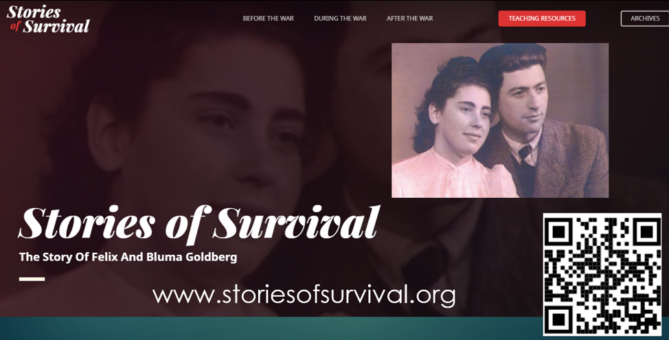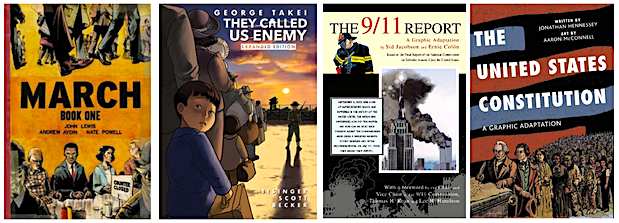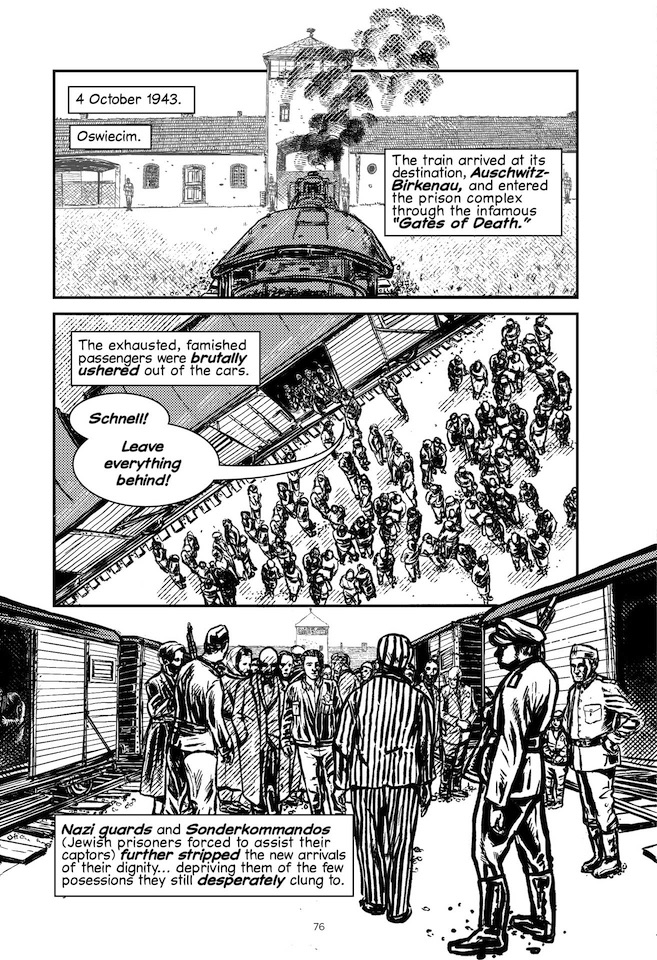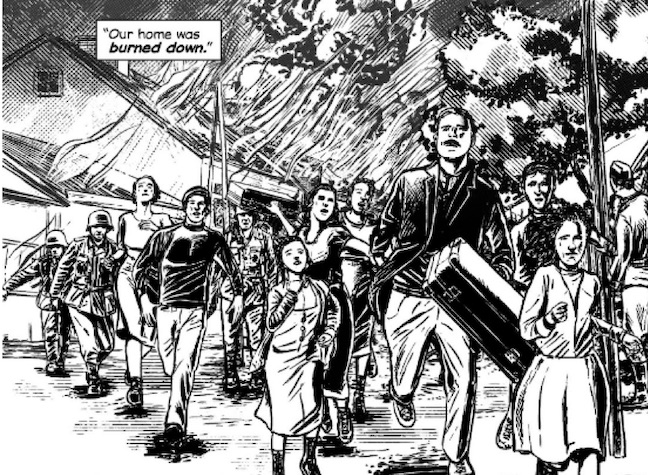YA Graphic Novel Tells Family’s Holocaust Story
By Frank W Baker

First, some media literacy perspective:
Recent surveys have indicated that many young people (and adults) are ignorant about what happened during the Holocaust. For example, a 2022 survey of 3500 North American students found “33% (didn’t) know what to think about the Holocaust, (thought) the number of Jews who died has been exaggerated, or question(ed) whether the Holocaust even happened.” (Source)
And this: “Research released by the Claims Conference found that 49% of U.S. millennials and generation Z have seen Holocaust denial or distortion content online – and that one in five U.S. millennials and generation Z surveyed in New York believe that Jews caused the Holocaust.“ (Source)
Where did your students learn about the Holocaust? Was it from a book, a photograph, a film, a video? Are they aware that 6 million Jews died during World War II – including one-and-a-half million children? Do you think current textbooks adequately address the Holocaust for your students? Would a supplemental text be helpful?
The Birth of an Idea
During the pandemic I listened to a webinar in which the director of the US Holocaust Memorial Museum said that students need to be exposed to both primary sources and personal narratives. That hit home to me, because I had already created a resource that included both of those important elements.
In 2000 Felix Goldberg, a Holocaust survivor, testified about his harrowing experience during the Day of Remembrance (Yom HaShoah) ceremony at our local synagogue. As he stepped off the stage, he handed me his speech and asked me to “do something with it.”
The something resulted in a web site – Stories of Survival – which details the journey he and his future wife took from war torn Poland to Columbia SC. As an education consultant, I presented the resource to educators attending the SC Council of Social Studies annual conference and to meetings of teachers with the Holocaust as part of their curriculum. The site contains primary sources, readings, and other valuable information that personalize the Holocaust story.
What Do Students Know?
As I thought about the work I had already accomplished with the web site, whose primary audience is teachers, I wondered aloud: what have I done for the students – who continue to be ill-informed about the Holocaust? That’s when the graphic novel idea was born.
I felt certain that graphic novels would be among THE most popular fiction forms in today’s school libraries. That was confirmed by many school library media specialists who also confirmed that non-fiction graphic storytelling is a favorite genre.
A University of South Carolina professor led me to a publisher and before long, I was hard at work on We Survived The Holocaust, a young adult (YA) graphic novel which details the story of Felix Goldberg & Bluma Tishgarten – two young Polish Jews who were caught up in Hitler’s Final Solution.
Both became slave laborers in the Nazi regime: she worked in a munitions factory; he worked in a coal mine. But that is only half of the story. They were subjected to inhumane conditions, horrific treatment and worse (much of which is not appropriate for a YA audience). Every day when they awoke, they did not know if it was to be their last on Earth. Theirs is a powerful story of risk, resilience and renewal.
The Goldberg family supported my idea and family members were instrumental in providing me with new details that were not already evident in the previously recorded videotaped testimonies and newspaper accounts of their parents.
As I began writing, I started visualizing scenes and conveying my thoughts in the script to Tim Ogline, our award-winning illustrator. Every week as we worked on this project I saw more of the story of these two young people “come to life.”
A couple of months ago, I looked again at Tim’s powerful image of Bluma’s family frantically running from their home in Poland as it was being burned by the Nazis. I immediately thought of the images I was now seeing in the news of Ukrainian residents running from THEIR homes. Yet another cruel tyrant was seeking to destroy the lives and culture of millions of people. How can this be happening again?
The Holocaust involves genocide, hatred, prejudice, antisemitism, indifference and much more. These themes did not end with World War II. Do your students know the reasons the Nazis targeted the Jews? Do your students understand how propaganda was used then to demonize the Jewish race?
– ALSO SEE –
Frank Baker’s MiddleWeb resource article:
12 Ways We Can Teach about the Holocaust
Do your students know what happened to many of the survivors? Are your students aware of the Nuremberg trials which brought some of those responsible to justice? Do they know about the other genocides in Cambodia, Armenia, Rwanda – just to name a few?
Facts Are Important
We are living in an age where disinformation, clickbait and fake news are rampant (the 2020 election and the pandemic are just two recent examples). Social media platforms like TikTok that are the most popular with young people are also ripe with false information, spoofed news stories and even Holocaust denials. Facebook and Twitter have both taken action recently to remove such posts, but that does not stop those who are determined to fool a media illiterate population.
I have been teaching media literacy for more than 20 years, and I can say this with certainty: Understanding genocide and the Holocaust means your students will need to employ the all-important critical thinking and critical viewing skills you teach them and to verify information as they read, watch and listen.
A Personal Note
This is my final post for MiddleWeb – after 10 years. I am eternally grateful to John Norton and Susan Curtis who edited my work and helped publish Close Reading The Media – a book that was a result of my media literacy experiences.
Thanks also to various education SmartBrief editors who saw the value of my topics and featured many of my posts so that thousands of other educators would have access. And thanks to YOU, the readers. It’s been an honor and privilege to write about media literacy. I hope you have found these posts valuable.
Images: © 2022 from “We Survived The Holocaust” by Frank W Baker. Art by Tim Ogline. Reprinted with permission.
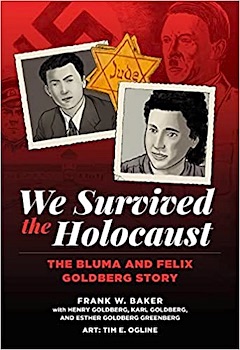
Frank has been a consistent presence on MiddleWeb for nearly a decade. His columns and blogposts are designed to help educators make the connection between popular culture, current events, teaching standards and media literacy. His lifelong work, which includes hundreds of workshops with teachers, was recognized in 2019 by UNESCO.
Frank maintains the popular Media Literacy Clearinghouse (MLC) education resource website. His most recent book, co-published by MiddleWeb and Routledge Eye on Education is Close Reading The Media: Literacy Lessons and Activities for Every Month of the School Year. He invites readers to follow MLC on Facebook and him on Twitter @fbaker.

